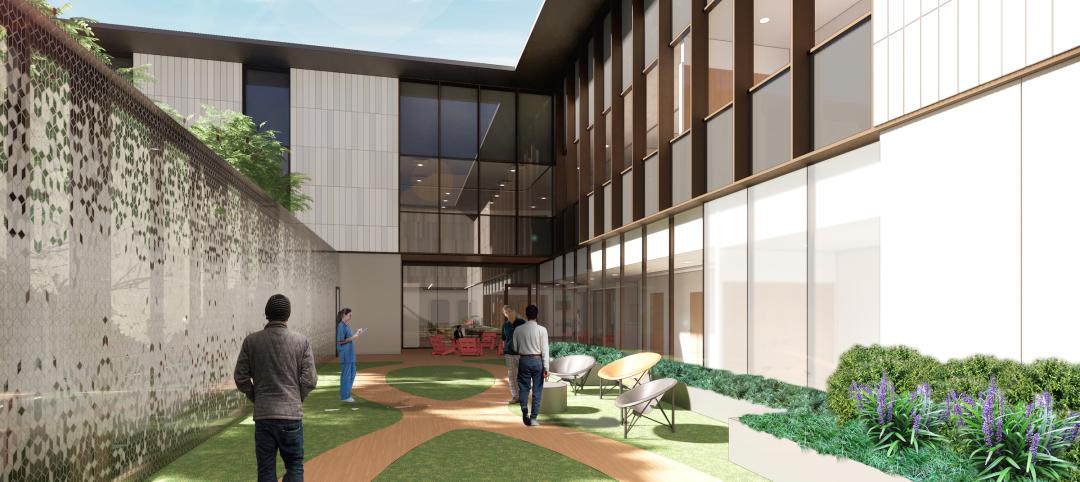Planners are often asked to test a facilities concept, define how much space it will take, and determine how much it will cost to complete. These questions are useful in the early concept phase of a project, but the basis for planning is missing; what am I solving for, and how does this potential “bricks and mortar” solution meet a defined service, market, or strategic need of the organization? It’s all about scoping the right concept before getting too far down the facility planning phase.
Defining and documenting project scope (the project intention, goal, or purpose) at the outset and controlling scope throughout the planning and delivery process is essential to ensuring the project vision becomes reality.
Ask yourself:
● What strategies and goals are we trying to achieve?
● What is the scope of the envisioned project and how was it defined?
Clearly defining the project, then articulating the scope and rationale to the team is paramount prior to launch. Scope typically relates to:
● Meeting the demands of the organization’s patients (service area)
● Cultivating a new or expanded service line opportunity
● Helping to improve throughput and operations
● Fixing an infrastructure or standard-of-care issue
● Scope control/communicating clear scope of work
● Attaining successful project definition
Rushing into design and construction without clearly defining the project scope can lead to project delay and frustration later in the process. If each team member cannot clearly articulate the scope of the project, you should stop and get everyone on the same page. Establish measurable project goals early to stay on track.
Scope Definition and Documentation
A facility project is a tactical element of a strategic plan or the output of business plan; this plan is built on the mission, vision, and goals of the organization. An organization’s strategic plan should include:
● Mission and vision identification
● SWOT analysis (strengths, weaknesses, opportunities, and threats)
● Internal and external environmental analysis
● Identification of gaps between mission/vision and internal/external needs
● Service needs identification
● Market-based needs and capacity analysis
● Strategic financial analysis
● Measurable strategic goals
● Tactics to meet the strategic goals of the organization
The needs identified in a strategic plan or focused business plan drive the tactical need for a project—not the other way around. A well-conceived scope guides facilities master planning and the detailed programming and design phases of a project. The scope of the project also acts as the base to define the project budget. Scope and budget are inextricably linked and need to be constantly checked against each other. It’s imperative that the two balance relative to a complete financial analysis of the project. If the project doesn’t “pencil” from a return-on-investment (ROI) perspective, then you’ll need to adjust scope and budget to get the project in line financially and still meet the market and service delivery goals of the organization.
If you conduct these analyses early, you have a better chance of making less costing changes if needed. As you move through the project delivery process, the ability to easily make changes decreases, and the cost of changes increases. Therefore, it’s important to appropriately define the scope, test it against the budget, and communicate and document it at the project outset.

Scope Control
Once scope is defined and clearly communicated to the project delivery team, it must be managed. Use scope control tools developed during the early planning phases and during each subsequent planning and design phase (master planning, space planning, schematic design, design development, and construction documents) to avoid scope creep. Scope creep refers to uncontrolled changes in a project’s defined scope. Typically, scope increases consist of new services, new features, or additional room elements without corresponding strategic or market demand justification. Avoid scope creep early by:
● Plan based on defined and justified needs rather than articulated wants
● Encourage stakeholder participation and plan based on facts and analysis to ensure buy-in from all parties
● Eliminate “pet” projects or elements with no financial strategic justification; this is “wish-casting” instead of “forecasting” and usually results in wasted finite resources at the expense of needed projects
● Clearly communicate scope to all key constituents and members of the project delivery team before embarking on detailed planning, design, and construction
● Track scope early and continue to track throughout the life of the project
Remember, you don’t need to eliminate scope changes all together. Sound strategic logic and rapidly changing market dynamics may dictate appropriate (controlled) changes to scope that are justified. Strong scope controls will identify acceptable variances and appropriately jump-start conversations as to the “why” for the changes.
Scope increases may require additional resources (e.g. staffing, space, equipment, capital costs, time, and operational costs) which must be justified or they could potentially put the project at risk. A few thousand square feet of scope creep could add millions to your total project cost, create delays if changed late in the design process, and cause a few headaches along the way. Allowing scope creep without correlating demand and revenue may require additional staffing resources, equipment, and furnishings, and carries the long-term operational cost without the requisite return on investment.
Interestingly scope can shrink too. Cutting revenue producing scope to make budget will have downward impact on potential ROI, the ability to meet service demand, and ability to offer services and recruit new staff. If a department is downsized to allow another area to grow and still remain within budget, make sure the downsized department is not rendered dysfunctional. If this happens, you may pay once the facility is operational.
There is great risk and cost to unfettered scope creep and a poorly defined project; therefore, proper planning and controls must be in place to prevent your project from being derailed. Items to consider:
● Thoroughly understand the project vision and involve all stakeholders in defining and documenting the project scope
● Utilize tools to monitor and control scope, and track the departmental “units” (e.g. number of rooms) and departmental space
● Expect changes; develop processes and criteria to evaluate proposed scope changes and to decide which changes are necessary to fulfill the intended vision
Start with acutely defining and documenting scope on the front end of the project. Control scope throughout the process to position yourself to control your project, instead of your project controlling you.
If you build it, will they come?
In summary, too often healthcare executives employ an “If you build it, they will come” mentality to a project. Sure, a new facility or space frequently have a halo effect and activity may spike initially. But if the services aren’t what the patient, caregivers, and physicians require, then they will stop coming. The analyses conducted in the planning phase will help to accurately define project scope; meet the strategic, market, and financial goals of leadership; and meet the needs of the healthcare organization’s community.
Related Stories
Sustainability | Apr 4, 2023
NIBS report: Decarbonizing the U.S. building sector will require massive, coordinated effort
Decarbonizing the building sector will require a massive, strategic, and coordinated effort by the public and private sectors, according to a report by the National Institute of Building Sciences (NIBS).
Healthcare Facilities | Mar 26, 2023
UC Davis Health opens new eye institute building for eye care, research, and training
UC Davis Health recently marked the opening of the new Ernest E. Tschannen Eye Institute Building and the expansion of the Ambulatory Care Center (ACC). Located in Sacramento, Calif., the Eye Center provides eye care, vision research, and training for specialists and investigators. With the new building, the Eye Center’s vision scientists can increase capacity for clinical trials by 50%.
Healthcare Facilities | Mar 25, 2023
California medical center breaks ground on behavioral health facility for both adults and children
In San Jose, Calif., Santa Clara Valley Medical Center (SCVMC) has broken ground on a new behavioral health facility: the Child, Adolescent, and Adult Behavioral Health Services Center. Designed by HGA, the center will bring together under one roof Santa Clara County’s behavioral health offerings, including Emergency Psychiatric Services and Urgent Care.
Healthcare Facilities | Mar 22, 2023
New Jersey’s new surgical tower features state’s first intraoperative MRI system
Hackensack (N.J.) University Medical Center recently opened its 530,000-sf Helena Theurer Pavilion, a nine-story surgical and intensive care tower designed by RSC Architects and Page. The county’s first hospital, Hackensack University Medical Center, a 781-bed nonprofit teaching and research hospital, was founded in 1888.
Project + Process Innovation | Mar 22, 2023
Onsite prefabrication for healthcare construction: It's more than a process, it's a partnership
Prefabrication can help project teams navigate an uncertain market. GBBN's Mickey LeRoy, AIA, ACHA, LEED AP, explains the difference between onsite and offsite prefabrication methods for healthcare construction projects.
Modular Building | Mar 20, 2023
3 ways prefabrication doubles as a sustainability strategy
Corie Baker, AIA, shares three modular Gresham Smith projects that found sustainability benefits from the use of prefabrication.
Building Tech | Mar 14, 2023
Reaping the benefits of offsite construction, with ICC's Ryan Colker
Ryan Colker, VP of Innovation at the International Code Council, discusses how municipal regulations and inspections are keeping up with the expansion of off-site manufacturing for commercial construction. Colker speaks with BD+C's John Caulfield.
Healthcare Facilities | Mar 13, 2023
Next-gen behavioral health facilities use design innovation as part of the treatment
An exponential increase in mental illness incidences triggers new behavioral health facilities whose design is part of the treatment.
Healthcare Facilities | Mar 6, 2023
NBBJ kicks off new design podcast with discussion on behavioral health facilities
During the second week of November, the architecture firm NBBJ launched a podcast series called Uplift, that focuses on the transformative power of design. Its first 30-minute episode homed in on designing for behavioral healthcare facilities, a hot topic given the increasing number of new construction and renovation projects in this subsector.
Sustainability | Mar 2, 2023
The next steps for a sustainable, decarbonized future
For building owners and developers, the push to net zero energy and carbon neutrality is no longer an academic discussion.

















